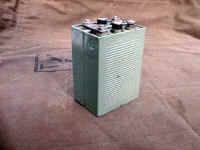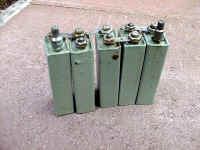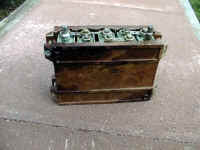I have written some data which refers to the larger accumulators normally encased in
metal boxes etc. The KNP-20 cells are often welded together in two's and used in the R-107
transceiver. The KH-24 is used in the R-105, R-108, R-109D series of transceivers. The
KN-13 or KN-14 accumulators are used with the R-323 and R-326 Receivers.

( KH24 ) 2KH-24 |
 |
Electrolytes and charging
In Russian receivers and transceivers such as the R-323 and R-326 receivers and the
R-105D, R-108D, R-109D and R-107 transceivers small nickel cadmium or nickel iron
accumulators are used. These are usually supplied without electrolyte and must therefore
be filled before charging. The main electrolyte is a solution of Potassium Hydroxide in
distilled (or de-ionised ) water. Potassium Hydroxide solution made up to the correct
strength will suffice but the original electrolyte also contained a small amount of
Lithium Hydroxide. Potassium Hydroxide is relatively easy to obtain and is cheap. Lithium
Hydroxide is neither cheap nor easy to obtain. When making up the solutions remember that
Potassium Hydroxide is very corrosive and poisonous. Wear rubber gloves and safety
glasses, and wash away any splashed material.Note 1:
Different types of cell may also require different solution strengths. Solutions should be
made up as near as possible at 20 degrees Celsius.
Note 2: Always free the vent plug when charging. A useful tip
to avoid trouble is to place the accumulators being charged in an empty polyethylene ice
cream container. Potassium Hydroxide electrolyte will shift more than the polish off your
table if let loose !!
Accumulators KN-13 or KN-14 and KN-24
Require electrolyte of density 1.2 g/ml. This may be obtained by dissolving 260
grammes of Anhydrous Potassium Hydroxide in about 750 mls of water then making this up to
a litre in volume with distilled water. If Lithium Hydroxide (solid) is available, 20
grams should be added to the solution before making up to a litre in volume. Remove the
vent plug from the accumulator and add electrolyte to the top of the plates. On the first
charging take the vent plug right out as the liquid may expand out of the casing or, you
may need to add more!.
Normal charging rate for the KN-13 or KN-14 accumulator is given as 3.3 Amp for 6
hours.
Normal charging rate for the KN-24 accumulator is given as 6 Amp for 6 hours or 4.5Amp for
7 to 8 hours.
Accumulators Type KNP-20 ( or 2 x KNP-20 )
Require electrolyte of density 1.16 g/ml. This should be made up using exactly
the same procedure as before except that the amount of Potassium Hydroxide to be used in
making up one litre of solution is 204 grams. Again, if available, 20 grams of Anhydrous
Lithium Hydroxide may be added during the preparation of the solution. Fill as before.
Normal charging rate for the KNP-20 accumulator is given as 4 Amp for 6 hours. |

( KN-13 ) HK-13 |

( KNP-20 ) HKN-20Y2 |
Visitors to this page since 30 July 1999
Back to Your Articles Index Page
Army Radio Sales Co. Home
Page





